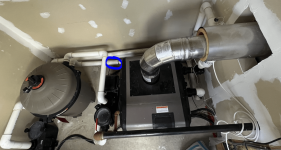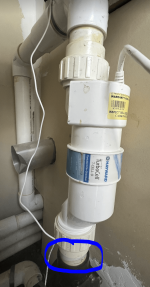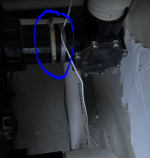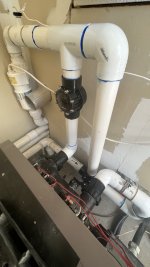Jandy valves has become the generic term for diverter valves. Like Xerox is the common term for copying.
Jandy, Pentair, Hayward, and others all make equivalent diverter valves that are functionally identical.
Thanks, getting closer (in my mind anyhow). You've been incredibly helpful!
A few more questions:
1. Looking at the plumbing and access, it will be near impossible to get to the diverter valve in the location I'm thinking. I assume it doesn't matter if the valve is a bit earlier in the chain? I'm thinking of instead putting it here, which would mean adding one additional 90 degree elbow and a bit more pipe, but much easier to get to and potentially easier to work within.

2. Trying to determine if I will need a new 90' check valve. The connections at each end of the check valve (circled below), are these cemented/glued in typically or is it some sort of compression type fitting that can be unscrewed? No sure if the small piece of pipe between the check valve and cell union is glued on to the check valve, if it is that probably means I will need a new 90' check valve which are a bit harder to locate in Toronto/Canada from my google search.
I assume into the heater outlet they are not glued on, but hard to tell without taking it apart. I hope they aren't glued on, as that would pose an issue as I need to either replace the heater or heat exchanger at the very least (see Q3 below).


3. Somewhat off topic, though it's how this whole project started. I have a super slow leak eminating from my heater, which presumably is a crack/hole in the heat exchanger. My pool person wants of course to just swap out the whole heater even though it's only ~4 years old. Probably chemistry issues caused pitting in the copper exchanger. So I'm thinking instead to just swap the exchanger which looks easy enough. The only other issue is that the heater doesn't hold a light. I hear a "swoosh" when the ignition clicks, the flame light on the heater comes on for a few seconds, and then goes out. A minute or so later, the process starts again and the heater tries to ignite, over and over. Would that likely just be the ignition rod needing to be replaced, as I assume a slight crack/leak in the heat exchanger wouldn't prevent the gas from lighting? Hesitant to buy a heat exc hanger only to find out there are unreparrable issues in the heater!
4. Curious, the check valves and diverter valves are typically rated as 1.5 to 2", or 2 to 2.5". If I have 2" pipe, which do I buy and how can there be a 1/2" swing?
5. Actually one more question. I live in Toronto, so winter is of course freezing for several months. Presumably with a bypass set up there are no additional winterizing things I should think about (additional drain plugs, etc)? I have someone close it each year so have never really paid attention.





